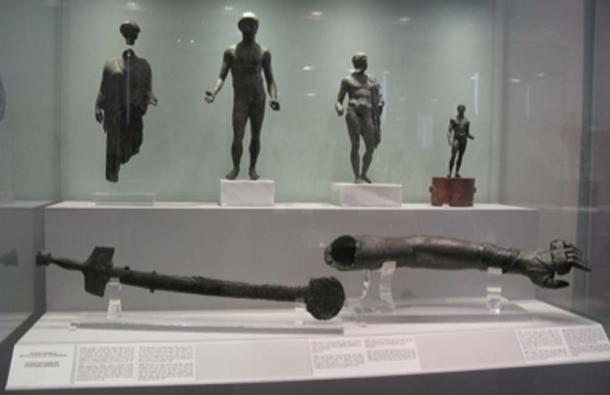Computer Dating to 87 BC Found Aboard Ancient Greek Shipwreck

Computer Dating to 87 BC Found Aboard Ancient Greek Shipwreck
A shipwreck from the days of ancient Greece has created an impressive treasure that shows that the Greek civilization of the time was much more advanced than we ever thought, around 87 BC.
It is assumed that the ship was a merchant vessel 131 feet long, and it wrecked off the coast of an island between the straits of Crete and the Peloponnese, known as Ailgila.
Ancient Origins reports: When the ship was first discovered and rescued in the early 1900s, just what you would expect to find onboard was already accounted for:
“In addition to the usual amphorae containing wine or other commodities, it bore a cargo of bronze and marble statuary and fine glassware.
“The life-size bronzes were antiques, a century or more old, but the other prestige objects were of recent manufacture.”

The purpose of the voyage appears to have been to deliver its goods at a foreign port:
“What is beyond doubt is that the ship was laden at one or more of the great ports of the Aegean: on the coast of Asia Minor, at one or more of the islands, or both. The location of its wreck shows that it was headed for the western Mediterranean, to deliver its cargo in ports of the Adriatic or farther west.”

The Ancient Computer
But the most impressive thing found on the sunken vessel was something it would seem isn’t possible: A computer. And yet the first computers weren’t even invented until the 20th century:

“A mechanical object composed of wood and metal, about the shape and dimensions of a shoebox. Though it probably lacked the visual appeal of the statues and glassware, it was delicate and precious, and one hopes it was packed securely in a crate or container to protect it from casual damage and from the elements.”
So what was this incredible device used for? Based on its configuration, the Antikythera Mechanism was probably used to predict the positions of the stars and other astronomical features as a sort of calendar that also served the purpose of helping when it came to astrological projections. It may also have been used for navigation since it helped locate heavenly bodies that would have been essential to an ancient seafarer.
The way the device worked was also a marvel of engineering:
“(It was) a box consisting of rectangular bronze plates forming its front and back faces, framed by a wooden casing, and a knob or crank protruding from the middle of one of the wooden sides. The dominant feature of the front face would have been a circular dial surrounded by two concentric ring-shaped scales and having a complicated assemblage of pointers radiating from its center.

“Most of the back face would have been taken up by two spiral slots with scales inscribed along them and radial pointers of rather complicated construction, and three smaller circular dials, with simpler pointers. All around the dial scales, in the spaces around the dials, and also on separate bronze plates that were stored against the machine’s faces and may have functioned as covers, one would have seen texts engraved in Greek letters, similar to the lettering of stone inscriptions but much tinier.”
Smithsonian did an in-depth article on the Antikythera Mechanism in 2015, and this description of the machine sounds like something that might have been created in a modern-day watch shop in Switzerland:

“Instead of hours and minutes, the hands displayed celestial time: one hand for the Sun, one for the Moon and one for each of the five planets visible to the naked eye—Mercury, Venus, Mars, Jupiter and Saturn. A rotating black and silver ball showed the phase of the Moon. Inscriptions explained which stars rose and set on any particular date. There were also two dial systems on the back of the case, each with a pin that followed its own spiral groove, like the needle on a record player. One of these dials was a calendar. The other showed the timing of lunar and solar eclipses.”
The device also provides a window into how the ancient Greeks saw the world:
“They came to believe that nature worked according to predefined rules, like a machine—an approach that forms the basis of our modern scientific views.”
So are computers a 20th century creation? Certainly the ones that inspired the advanced devices we use at home and work today are from the last century. But ancient people had their own versions, too. And in their own way, they were just as incredible.